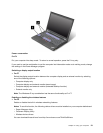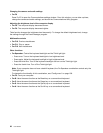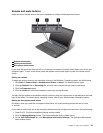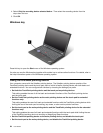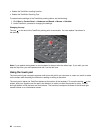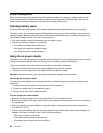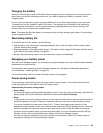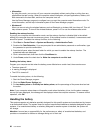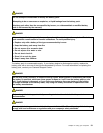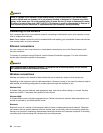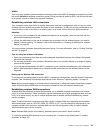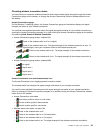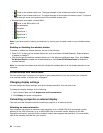
Charging the battery
When you check battery status and nd that the percentage of power remaining is low or when the power
alarm alerts you that the remaining power is low, you need to charge your battery or replace it with a
charged battery.
If an ac outlet is convenient, plug the ac power adapter into it, and then insert the jack into the computer.
The battery will be fully charged in about 3 to 6 hours. The charging time is affected by the battery size
and the physical environment. You can check the battery charging status at any time by looking at the
battery meter icon at the Windows notication area.
Note: To increase the life of the battery, the computer does not start recharging the battery if the remaining
power is greater than 95%.
Maximizing battery life
To maximize the life of the battery, do the following:
• Use the battery until the charge is completely depleted, that is, use the battery until the battery status
indicator starts blinking orange.
• Recharge the battery completely before using it. The battery is fully charged if the battery indicator shows
green when the ac power adapter is plugged in.
• Always use power-saving modes, such as screen blank, sleep, and hibernation.
Managing your battery power
With the Power Manager program, you can adjust your power settings to give you the best balance between
performance and power saving.
For instructions on accessing the Power Manager program, see “Accessing ThinkVantage applications
on the Windows 7 operating system” on page 13.
For more information, refer to the help information system of the program.
Power-saving modes
There are several modes that you can use at any time to conserve power. This section introduces each
mode and gives tips on the effective use of the battery power.
Understanding the power-saving modes
• Screen blank
The computer display requires considerable battery power. To turn off power to the display, right-click the
battery gauge icon from the Windows notication area and select Power off display.
• Sleep
In sleep mode, your work is saved to memory, and then the solid state drive or the hard disk drive and the
computer display are turned off. When your computer wakes up, your work is restored within seconds.
To put your computer into sleep mode, press Fn+F4. To return from sleep mode, press the Fn key.
Depending on the computer model, your computer might support the 30 Day Standby function. When this
function is enabled, the computer consumes even less power in sleep mode and takes only seconds
to resume normal operation when you press the power button. For more information about the 30 Day
Standby function, refer to the help information system of the Power Manager program.
You also can use the combination to put the computer into hibernation mode or do-nothing mode by
changing the settings in the Power Manager program.
Chapter 2. Using your computer 29



